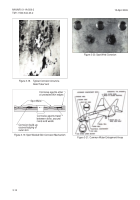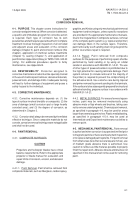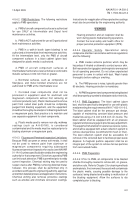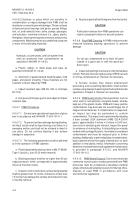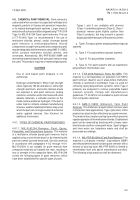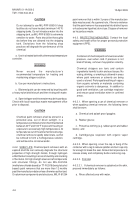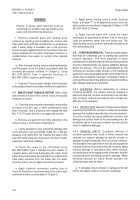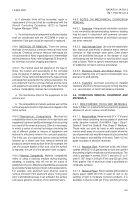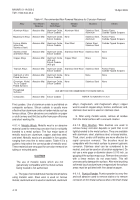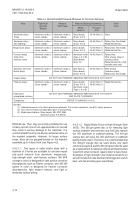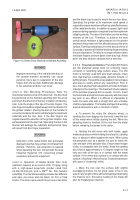TM-1-1500-344-23-2 - Page 84 of 240
4-8
NAVAIR 01-1A-509-2
TM 1-1500-344-23-2
15 April 2009
WARNING
Rinsing of epoxy paint removers shall be
conducted in a suitable area specified by local
safety and environmental directives.
f. Remove loosened paint and residual paint
remover by washing and scrubbing the surface with
fresh water and a stiff nylon bristle brush or an abrasive
pad. If water spray is available, use a low pressure
stream of water applied directly to the surface while it is
being scrubbed. Do not allow rinsed paint remover or
contaminated rinse water to contact other painted
surfaces.
g. After thorough rinsing, remove masking materials
and thoroughly clean the area in accordance with the
cleaning processes outlined in Chapter 2, using
MIL-PRF-85570 Type II (general cleaning) or
MIL-PRF-29602 (aqueous parts washer).
h. Disposal. Process spent stripper and rinse water
as hazardous waste in accordance with local regulations.
4-7. MINOR PAINT DAMAGE REPAIR.
Minor nicks
and scratches in paint films can be easily and quickly
repaired as follows:
a. Clean the area around the damage to ensure that
all traces of oil, dirt, salt, or other contaminants have
been removed. Use a cleaning cloth dampened with
MIL-T-81772 paint thinner or an approved solvent.
b. Remove any paint film not firmly adhering to the
surface using a nonmetallic scraping tool.
c. Lightly abrade the area around the damage with
a fine abrasive mat (A-A-58054 Grade B) or 320 grit
abrasive cloth (ANSI B74.18). Feather the edge of the
paint film while using care to prevent removal of metal,
especially aluminum cladding.
d. Clean the area to be refinished using
MIL-PRF-85570 Type II (diluted one part cleaner to
14 parts water) and rinse thoroughly with clean, fresh
water. Ensure that all traces of oil and other contaminants
have been removed from the metal skin For water
sensitive areas, use an approved cleaning solvent.
e. Apply chemical conversion coating (use of
Touch-N-Prep Pen is recommended) to the clean, bare
aluminum surface as described in Chapter 5.
f. Apply primer coating using a small, touch-up
brush, a Sempen™, or an approved aerosol touch-up
paint system as described in Appendix A (Navy) or TM
55-1500-3554-23 (Army).
g. Apply topcoat paint film, using the same
techniques as described for primer. Two or three thin
coats are preferred, rather than one heavy coat. The
repaired area should have the same paint thickness as
the surrounding area.
4-8.
CORROSION REMOVAL
. There are certain factors
that must be considered prior to starting any corrosion
removal operation. The most important of these
considerations is that the removal of the corrosion products
must be completed while not causing additional damage
during the process. This can be accomplished by first
removing all corrosion visible through a 10X magnifying
glass, then removing an additional two mils (0.0020 inch) to
ensure that all deposits have been eliminated. Failure to
remove all the corrosion may allow the corrosion to continue
after affected surfaces are refinished.
4-8.1. CLEANING. Before attempting to remove
corrosion products, the surface must be stripped of
paint and cleaned. Surface contaminants will interfere
with corrosion removal procedures and increase the
difficulty of the operation.
4-8.2. PROTECTION. Adjacent components and parts
must be protected from corrosion residue and possible
damage that could be caused by the removal operation.
Corrosion residue can cause additional corrosion and
damage the surface finish of the surrounding area. An
accidental slip of a corrosion removal tool can quickly
result in additional damage.
4-8.3. DAMAGE LIMITS. Complete removal of
corrosion products may result in metal removal that
exceeds the amount allowed by specific aircraft or
equipment repair handbooks. Prior to corrosion removal,
the allowable limits specified in aircraft and equipment
manuals and technical orders must be checked. Metal
removal damage is cumulative: prior metal removal,
including areas on the opposite side of the part, must be
considered when assessing corrosion damage. When
removing corrosion on critical aircraft structure, the
following steps shall be taken:
a. If allowable metal removal or damage limits will
not be exceeded, remove corrosion completely.
Back to Top

